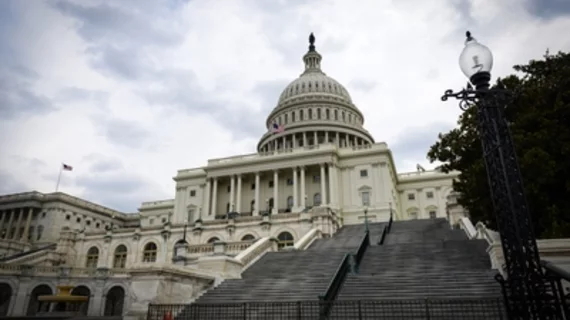Several medical imaging societies ask to be involved in Congressional Medicare reform efforts
Numerous medical imaging societies were among about 100 healthcare groups that signed onto a letter sent to Congressional leaders Feb. 25 that requests collaboration as legislators work to reform the Medicare physician payment system.
Among the medical imaging related societies that signed the letter included the American College of Radiology (ACR), Radiology Business Management Association (RBMA), Society of Interventional Radiology (SIR), Society of Nuclear Medicine and Molecular Imaging (SNMMI), American Society for Radiation Oncology (ASTRO), American Society of Echocardiography (ASE), American Society of Nuclear Cardiology (ASNC), and the Association for Quality Imaging. In total, the organizations that signed on to the letter represent more than 1 million physician and nonphysician healthcare clinicians.
"We respectfully request that your committees collaborate with the provider community to immediately initiate formal proceedings (hearing, roundtables, expert panels, etc.) to discuss potential reforms to the Medicare physician payment system to ensure continued beneficiary access to care," the societies requested in the letter.
The societies said they appreciated Congress’ actions over the past several years to mitigate scheduled cuts to the Medicare Physician Fee Schedule (MPFS). But, the letter states systemic issues, such as the negative impact of the Medicare physician fee schedule’s budget neutrality requirements and the lack of an annual inflationary updates to payments, continue to generate significant instability for clinicians moving forward. The societies said this threatens beneficiary access to essential healthcare services. The COVID-19 pandemic has also compounded these existing issues, the societies added.
Other challenges cited include the Medicare Access and CHIP Reauthorization Act’s (MACRA) Quality Payment Program (QPP), which have prevented most clinicians from meaningfully participating in the program.
"Nonphysician clinicians are still not fully integrated in the Merit-Based Incentive Payment System (MIPS) because most are ineligible to report cost and promoting interoperability measures, which account for 55% of MIPS scoring," the letter to Congress stated. "The incentive payments have also been historically low, far below the 9% Congress intended, rendering them an ineffective mechanism to offset the reductions required by budget neutrality."
For this reason, the signatories of the letter said it is essential to improve MIPS and Alternative Payment Models, including extending the current incentives for participating in Advanced APMS.
Under the current payment system, many clinicians continue to face steep annual reductions in their Medicare payments, the letter stated. This has largely been due to the inherent instability of the MPFS, coupled with the shortcomings of MACRA’s QPP, which the societies said has created an environment where many practices have seen their payments decrease year-over-year. This decrease in payments has also been compounded by increasing costs and growing inflation.
"Building on the broad bipartisan and bicameral support for recent efforts to mitigate steep payment cuts, our organizations welcome the opportunity to work together to establish a pathway for identifying policy solutions that will ensure long-term stability for the MPFS," the societies concluded in the letter. "Millions of seniors rely on the Medicare program, and we must work to ensure it remains a robust and dependable option for those who need it the most. We remain committed to partnering with Congress to identify and advance necessary reforms and appreciate your continued support of the healthcare clinicians on whom many Americans rely."
AMA pushes for Medicare payment reform
The American Medical Association (AMA) was among the societies that signed the letter, and it has made Medicare physician payment reform one of its key priorities in 2022. The AMA published an update Feb. 25 on its efforts to fix the Medicare pay system once and for all.
The AMA cited the major victory it and other societies had in December 2021 in halting payment cuts from the Centers of Medicare and Medicaid Services (CMS) and said that win forms the basis of this year’s chief legislative focus.
“Stopping the proposed Medicare payment cuts was a major victory, but this yearly cliffhanger must end—the broken record must stop playing,” Bobby Mukkamala, MD, chair of the AMA Board of Trustees, said in the AMA article. “We are calling on Congress to bring about a permanent solution to end the annual battles that threaten the solvency of physician practices.”
The AMA said physicians are facing a continuing statutory freeze in annual Medicare physician payments that is scheduled to last until 2026. After that, payment updates will resume, but only at a rate of 0.25% a year indefinitely, with the society said is not sustainable.
The AMA said there needs to be a reliable Medicare physician payment update that should should keep up with inflation and rising practice costs, while encouraging innovation. The AMA update also said there needs to be new ways to reduce the administrative and financial burdens of MIPS participation.
Related Medicare Payments Content:
Congress reaches bipartisan deal to blunt Medicare cuts, drawing praise from radiology advocates
Diagnostic radiology absorbed a 44% Medicare reimbursement reduction over the last decade
Senate finalizes radiologist relief from Medicare cuts, sending final bill to president
Medicare spending on diagnostic radiology services fell $890M below expected levels in 2020
Physician members of Congress propose extending temporary 3.75% Medicare pay bump through 2022
Radiologists receive commercial insurance payments at 180% of Medicare pricing

